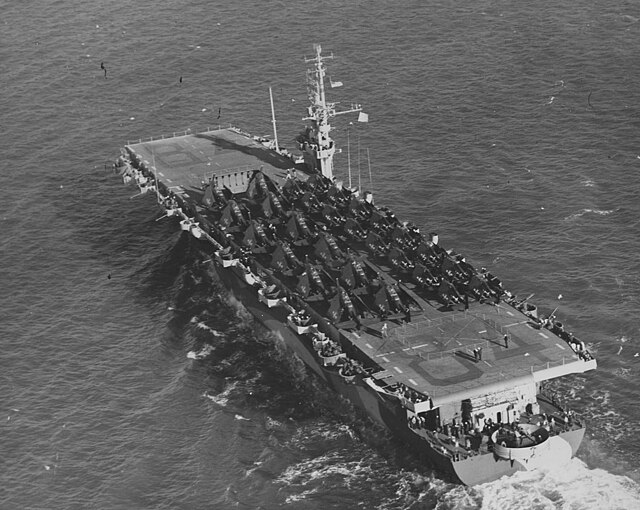USS Shamrock Bay (CVE-84) was the thirtieth of fifty Casablanca-class escort carriers built for the United States Navy during World War II. She was named after Shamrock Bay, located within Baranof Island, of the Territory of Alaska. The ship was launched in February 1944, commissioned in March, and served in support of the Invasion of Lingayen Gulf, the Invasion of Iwo Jima and the Battle of Okinawa. Postwar, she participated in Operation Magic Carpet. She was decommissioned in July 1946, when she was mothballed in the Atlantic Reserve Fleet. Ultimately, she was broken up in November 1959.
USS Shamrock Bay underway carrying Composite Squadron (VC) 42 off of Norfolk, Virginia, 11 November 1944.
Three Casablanca-class escort carriers berthed at Astoria, Oregon, 6 April 1944. The bottommost carrier is Shamrock Bay.
Shamrock Bay's port hull is photographed by a blimp from Airship Patrol Squadron (ZP) 12 off the East Coast on 26 October 1944, as it returns to Norfolk, Virginia.
Army Air Corps P-47D variant Thunderbolt fighters are photographed packed into the hangar deck of Shamrock Bay during a transport run in the Atlantic Ocean sometime in July 1944. Note the basketball hoop at the top-left of the image and the movie screen in the center background.
Casablanca-class escort carrier
The Casablanca-class escort carrier was a series of escort carriers constructed for the United States Navy during World War II. They are the most numerous class of aircraft carriers ever built. Fifty were laid down, launched and commissioned within the space of less than two years – 3 November 1942 through to 8 July 1944. Despite their numbers, and the preservation of more famous and larger carriers as museums, none of these modest ships survive today. Five were lost to enemy action during World War II and the remainder were scrapped.
USS Guadalcanal, 1944
Casablanca-class escort carriers fitting out, circa April 1944.
USS Lunga Point
USS Gambier Bay under fire at Samar, 1944








